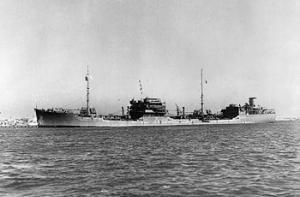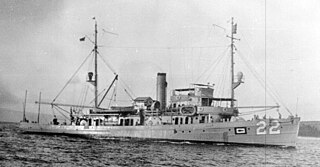
The Royal Fleet Auxiliary (RFA) is a naval auxiliary fleet owned by the UK's Ministry of Defence. It is a component of His Majesty's Naval Service and provides logistical and operational support to the Royal Navy and Royal Marines. The RFA ensures the Royal Navy is supplied and supported by providing fuel and stores through replenishment at sea, transporting Royal Marines and British Army personnel, providing medical care and transporting equipment and essentials around the world. In addition the RFA acts independently providing humanitarian aid, counter piracy and counter narcotic patrols together with assisting the Royal Navy in preventing conflict and securing international trade. They are a uniformed civilian branch of the Royal Navy staffed by British merchant sailors. The RFA is one of five RN fighting arms.
This is a list of the naval forces from the United Kingdom that took part in the Falklands War, often referred to as "the Task Force" in the context of the war. For a list of naval forces from Argentina, see Argentine naval forces in the Falklands War.

RFA Diligence was a forward repair ship of the Royal Fleet Auxiliary. Launched in 1981 as a support ship for North Sea oil rigs, she was chartered by the British government to support naval activities during the 1982 Falklands War and was later bought outright as a fleet maintenance vessel. She gave assistance to the damaged USS Tripoli and Princeton in the 1991 Gulf War, and to Sri Lanka after the 2005 tsunami. She typically had deployments of 5-8 years in support of the Trafalgar-class submarine on duty east of Suez, with a secondary role as a mothership for British and US minesweepers in the Persian Gulf. Until 2016 Diligence was set to go out of service in 2020. However in August 2016, the UK Ministry of Defence placed an advert for the sale of RFA Diligence. As of 2016 the option for the delivery of future operational maintenance and repair capability for the RFA remained under consideration. However, the 2021 British defence white paper made no specific mention of the need for this capability. In April 2023, it was revealed that the ship was to be scrapped after no suitable buyers materialised, & she was moved out of 3 Basin across to Fareham Trots to await her final journey to the scrapyard.

The British Pacific Fleet (BPF) was a Royal Navy formation that saw action against Japan during the Second World War. It was formed from aircraft carriers, other surface warships, submarines and supply vessels of the RN and British Commonwealth navies in November 1944.
RFA King Salvor (A291), initially HMS King Salvor (W191), was the lead ship of a class of 12 salvage vessels of the Royal Fleet Auxiliary. A 13th ship was completed as the submarine rescue vessel HMS Reclaim for the Royal Navy.
RFA Ocean Salvor (A492) was a salvage vessel of the Royal Fleet Auxiliary.

RFA Cedardale (A380) was a Dale-class fleet tanker of the Royal Fleet Auxiliary. She was originally one of two ships which were purchased by the British Admiralty from the Anglo Saxon Petroleum Co for evaluation purposes. Cedardale was decommissioned on 15 November 1959 and laid up at Hong Kong.

HMAS Choules (L100) is a Bay-class landing ship that served with the Royal Fleet Auxiliary (RFA) from 2006 to 2011, before being purchased by the Royal Australian Navy (RAN). The vessel was built as RFA Largs Bay by Swan Hunter in Wallsend, Tyne and Wear. She was named after Largs Bay in Ayrshire, Scotland, and entered service in November 2006. During her career with the RFA, Largs Bay served as the British ship assigned to patrol the Falkland Islands in 2008, and delivered relief supplies following the 2010 Haiti earthquake.

USS Guardian (MCM-5) was an Avenger-class mine countermeasures ship of the United States Navy, and was the second Navy ship to bear that name. The hulls of the Avenger-class ships were constructed of wood with an external coat of fiberglass.

HMS Edinburgh was a Town-class light cruiser of the Royal Navy, which served during the Second World War. She was one of the last two Town class cruisers, which formed the Edinburgh sub-class. Edinburgh saw a great deal of combat service during the Second World War, especially in the North Sea and the Arctic Sea, where she was sunk by torpedoes in 1942.

USNS Salvor (T-ARS-52) is a Safeguard-class rescue and salvage ship, the second United States Navy ship of that name.

USS Surfbird (AM-383) was an Auk-class minesweeper built during World War II for the United States Navy. She was the only U.S. Navy ship named for the surfbird.

RFA Wave Knight is a Wave-class fast fleet tanker of the Royal Fleet Auxiliary (RFA) of the United Kingdom tasked with providing fuel, food, fresh water, ammunition and other supplies to Royal Navy vessels around the world.

USNS Safeguard (T-ARS-50), formerly USS Safeguard (ARS-50), is the lead ship of her class and the second United States Navy ship of that name.

USS Waxwing (AM-389) was an Auk-class minesweeper acquired by the United States Navy for the dangerous task of removing mines from minefields laid in the water to prevent ships from passing. She was the only U.S. Navy ship named for the waxwing, any of several American and Asiatic songbirds which are for the most part brown and are characterized by predominant crests and velvety plumage.

USS Widgeon (AM-22/ASR-1) was an Lapwing-class minesweeper acquired by the United States Navy for the dangerous task of removing mines from minefields laid in the water to prevent ships from passing. Later converted to a submarine rescue ship. Widgeon was named by the Navy after the widgeon, a freshwater duck.

USS Flamingo (AM-32) was a Lapwing-class minesweeper built for the United States Navy near the end of World War I. After service overseas clearing mines after the Armistice, the ship was laid up until 1922 when she was transferred to the United States Department of Commerce for use by the United States Coast and Geodetic Survey. Renamed USC&GS Guide, the ship operated as a survey vessel along the West Coast of the United States for 17 years, making significant contributions to navigation, hydrographic surveying, and oceanography. In June 1941, Guide was transferred back to the Navy, converted into a salvage ship, and renamed USS Viking (ARS-1). As Viking, she worked primarily from bases in California until 1953, when she was sold for scrapping.

USNS Big Horn (T-AO-198) is a Henry J. Kaiser-class replenishment oiler of the United States Navy.
Empire Faun was a 846 GRT Coastal tanker that was built in 1942 by Goole Shipbuilding and Repairing Co Ltd, Goole, United Kingdom for the Ministry of War Transport (MoWT). She was loaned to the Greek Navy in 1959 as BN Poseidon. In 1959, she was transferred to the Royal Fleet Auxiliary as RFA Sirius. She was sold to the Greek Navy in 1962.















